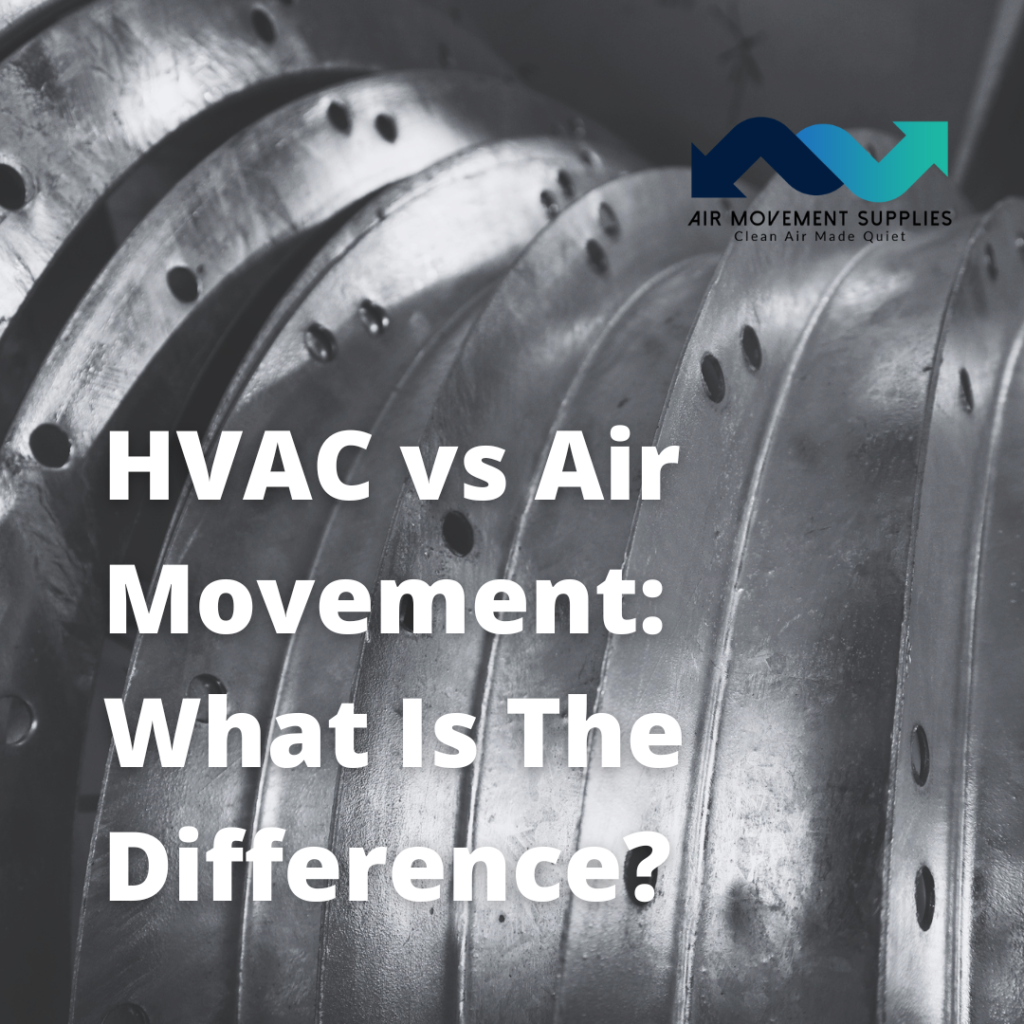HVAC vs Air Movement: What Is The Difference?
- Max Underhay
- September 1, 2022
Share this article:

What is the HVAC industry?
HVAC stands for heating, ventilation, and air conditioning. It is the technology of environmental comfort in a small place by providing heat, ventilation, and air conditioning to individuals in the home or office.
HVAC systems are used for residential, commercial, and industrial applications. They can be installed in both new construction projects as well as existing buildings where they were never previously installed. As air conditioning systems are required in cars, trains, aeroplanes, ships, and submarines, it is also crucial to vehicle design.
What is the Air Movement Industry?
The Air Movement industry is a subset of the HVAC industry. As you might expect, it’s all about moving air, but the specialty of this market is that they’re focused on high-performance fans and blowers, as well as their application in HVAC systems. The growth rate of this niche market has been increasing over time, so much so that it has become an emerging field with a lot of potential behind it.
Home Air Movement
In a home or office setting, HVAC systems are used to make sure that the building’s atmosphere is comfortable for occupants.
HVAC units serve multiple purposes: they provide temperature control, circulate air throughout the space and filter out dust particles and other contaminants from it. Some buildings may have more than one HVAC system — for example, an office building with several floors may require separate systems for each floor. Because there are many kinds of HVAC systems available today (such as ductless mini splits), choosing an appropriate one can be difficult without some basic knowledge about how these devices work.
Industrial Air Movement
Industrial air movement systems are used in many different industries. You’ll find them in factories, warehouses, and other industrial settings. There are a few different types of industrial air movement systems that you can choose from to achieve your desired effects.
- Air Handling Units – These units are designed for moderate temperature and humidity conditions, so they don’t use any refrigeration or dehumidification equipment. They’re best for areas with light occupancy where there aren’t any extreme temperature changes happening (or if there are extreme temperature changes happening regularly).
- Heat Recovery Ventilators (HRVs) – HRVs collect stale indoor air and exchange it with fresh outdoor air—they’re great at improving indoor air quality without increasing energy consumption because they don’t actually move much volume through themselves. Instead, they rely on convective airflow between rooms/spaces as well as natural thermal transfer processes like conduction or radiation between surfaces located within each room/space to transfer heat back into your home when necessary during colder months.
You can see how each of these features work together to provide you with the best possible indoor air quality and comfort year-round. It’s important that your HVAC system is working properly and efficiently at all times. If it isn’t, then that means some of those things aren’t happening correctly either which could lead to potentially dangerous problems down the road like carbon monoxide poisoning from a faulty combustion appliance not working as intended (which is why having an inspection done every year or so by someone who knows what they’re doing is so important).
VAV Systems
VAV systems use an air handling unit (AHU) to provide air at a changeable temperature and airflow rate. Many commercial structures, including hospitals, schools, office buildings, and other sizable commercial structures, use VAV systems to satisfy the variable heating and cooling needs of various building zones.
In these types of facilities there are many different types of spaces that need to be controlled separately. To do this the VAV system uses a centralized control system that monitors the building’s occupancy and temperature. The central computer then sends signals to each VAV box where it is connected by copper pipes or ducts to control air flow into specific areas of the building. This allows for individual zones within a large facility (such as an office) to be isolated from one another so their temperatures can be regulated separately from each other.
HVAC Systems
Depending on their design and the locations they are utilised in, HVAC systems can come in a wide variety of sizes and shapes and offer a variety of advantages. Any combination of the following may be included in units:
- Boilers
- Air conditioning units
- Ducts and moisture vents
HVAC systems can be further defined by their type of fuel source: gas-fired boilers (fossil fuel), electric resistance heaters (electricity) or solar collectors that heat water using the sun’s energy. Most residential homes use forced-air furnaces as part of their HVAC system.
Benefits of Air Movement Systems
One of the most important benefits of air movement systems is that they can help with comfort, indoor air quality (IAQ), and energy efficiency. Air movement systems are also great for homes and commercial buildings alike.
Air movement systems work by bringing fresh outside air into your home or building while also taking out stale indoor air. This helps to keep the temperature more consistent throughout the year so you don’t have to use as many energy-intensive heating and cooling methods.
Since these ventilation methods create more natural airflow throughout a space, they’re often used in industrial settings where employees need their own personal climate control system while working at desks or sitting in offices that aren’t optimally designed for comfort. For example: if someone works primarily indoors but needs some fresh air every once in a while (like during lunch breaks) then a simple fan would suffice; however if someone has multiple responsibilities such as traveling between different rooms or buildings each day then an advanced HVAC system might be necessary instead because it provides greater flexibility than just running around with a small portable fan tucked under one arm all day long!
The HVAC and Air Movement industry is growing
HVAC is a $136 billion sector that is expanding quickly, and for good reason: It plays a crucial role in ensuring that people are comfortable in both their homes and places of employment. The air movement industry is a $6 billion and expanding industry, according to the Air Movement and Control Association (AMCA). More than 20 million buildings in the US contain air handling equipment for HVAC, according to the AMCA.
Conclusion
Building heating and cooling are handled by HVAC. Additionally, it provides suitable ventilation, allowing moisture to evaporate. Any form of technology that moves or circulates indoor air from one place to another within a building or residence is referred to as air movement, which is a subset of HVAC. This might involve ventilation systems, fans, and blowers, among other things.
With good cause, the HVAC and air movement sector is expanding. It not only can reduce energy costs, but it also gives your staff and consumers access to a more comfortable indoor space. There is no better time than now to invest in an air movement system if you operate a business that needs some fresh air!
Max Underhay
Table of Contents
Related Articles

HVAC Guide to Splitters and Pods
If you’re in the market for a new HVAC system, you may have come across the terms “pods” and “splitters”. But what are they exactly? How do they work? What is their purpose? And which one should you go with? Let us help clear some things up!

Material Price Increase and Stock Shortage – What to Expect.
With prices continuing to rise and no lack of material shortages, here’s what to expect for the future.

Why Buy British?
Buying British means more than just buying locally, but it is the support of our ever-growing and strengthening British manufacturing community.
